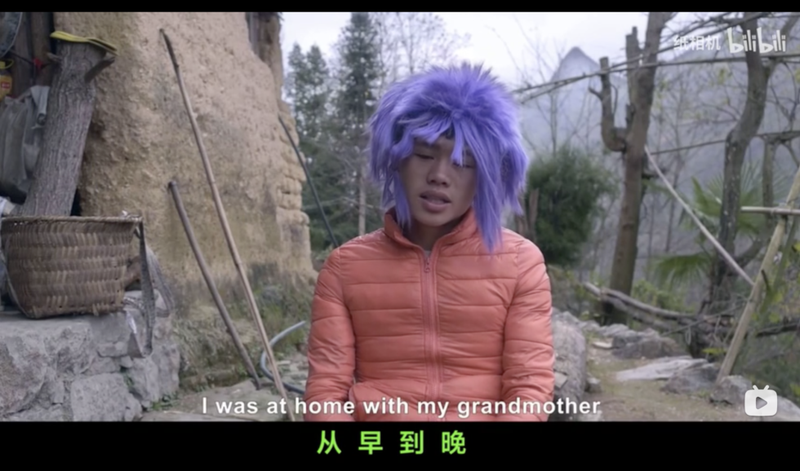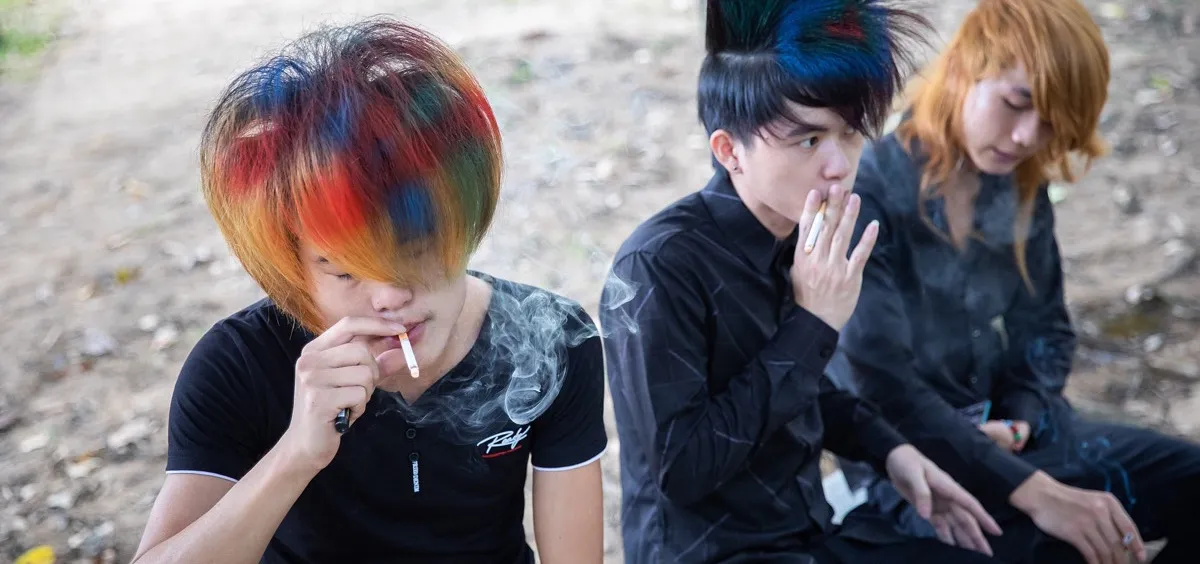A love letter to the despised working class community
It was never really about the hair.
Shamate (杀马特), a working class subculture that flared into exuberant and multi-colored existence in 2007, is at the center of director Li Yifan’s newest documentary We Were Smart, but the film’s emotional core is much deeper.
A style embraced by young people working in factory compounds in China’s manufacturing towns, the neon updos and punk-like fashion of shamate became the subject of public derision in the mid-2010s, ridiculed by broad swaths of society as freakish, low-class, and a public nuisance. The world of shamate was practically stamped from public existence by 2015 through hate campaigns by internet users that resulted in online shamate communities being deleted and blocked, and some shamate even facing death threats or beaten in the streets.
But many cannot forget the community that shaped their youths, or even saved their lives. We Were Smart retells the story you thought you knew from the perspective of young people who found strength and meaning in the shamate identity, with poignant human depth and sociological breadth. “I shot shamate telling their personal histories—a spiritual history,” said director Li at an online post-screening talk last December. “It’s also a part of the history of post-90s rural migrant workers.”
Under mountains of hair gel and dye emerges the pain and anxiety of a generation of left-behind children, the loneliness and monotony of factory work, and the way such a parched existence can become fodder for a massive movement of creativity and expression. We Were Smart weaves individual accounts of searching for work, love, and self, which come together as a larger tale about China’s migration, labor, and industrialization.

Video still from We Were Smart《杀马特我爱你》
“I believed a hairstyle could change a person,” said An Xiaohui, one of 67 shamate interviewed in over five provinces by Li and his collaborator, prominent shamate Luo Fuxing, who also stars in the film. Shot from 2017, Li combines on-cam interviews with archival footage bought from shamate groups, phone videos shot by factory workers of assembly lines and dormitory life, and footage from a few enduring shamate strongholds in Guangdong province, piecing together the history of the movement from its birth to its death.
The film opens with a split screen of phone videos from assembly lines taken by factory workers, and each subject recounting how old they were when they left home—11 years old for the youngest, and 17 for the eldest. “At that time in my village, girls didn’t really go to school. I didn’t even finish the second grade,” An recalls. At 12 years old, she and her cousin hopped on a bus to the city, undid their pigtails to look older, and entered the factory floor.
Hailing from villages from Yunnan, Guangxi, Qinghai, Henan, and 14 provinces and regions across central and western China, interviewees recount coming to the city, and being scammed and bullied. Some took up shamate as a defensive shield. “You made yourself hard and sharp like a porcupine, nobody could touch you,” says Lisa, who left home at 16 and now works in a beauty salon in Baise, Guangxi. “It didn’t matter if I was really weak, because that feeling was really, really lonely.”
Others took up shamate out of a desire to be noticed, and felt seen. “I could only relieve some pressure by deciding how I did my hair, and let some people know that I’m special,” says Yun Xiaoshuai, who left home at 14 years old and now works in construction in Kunming, Yunnan province. “Even if someone is yelling at you, someone is speaking to you.”
Bai Feifei, who left home at 15 years old and now works in a beauty salon in Guangzhou, Guangdong province, told the camera that she was depressed, and had been reading online about ways to end her life. Then she thought about another woman in the factory who “had her hair in two or three colors, and wore stilettos.” Bai effused, “I could feel the strength of her personality. I was already starting to think: They are free. They are individuals. They were the opposite of my parents. They could do what they wanted. As I got to know them, I realized, my life was mine to live, even if I was wrong.”

Video still from We Were Smart《杀马特我爱你》showing photos of interviewees when they had first left home
Some call the film “empathetic,” but it goes further than that—the film succeeds because it largely allows shamate to tell their own stories. They laugh to the camera as if reminiscing to an old friend, with painful awareness of the intensity and naivety of their younger days.
Story by story, the film’s thesis comes into focus: that the style became a powerful means of self-preservation or self-expression. For some of the interviewees, the community around shamate became family, as they were alone in a foreign city: people they could tell anything to (“You start by talking about hair, and then there’s nothing you can’t talk about”), people who would come to their aid if they were attacked (“You feel that you have the strength of an entire clan behind you”), or could even introduce them to a new job.
Visually, the film doesn’t hold back gruesome punches, whether videos of fingers bloodied in work accidents, or photos of self-harm induced by heartbreak. The footage of factory life comes from over 900 clips bought by the production team from current workers for 1,000 RMB apiece.
Within the tightly-packed structure, there are a few much-needed breaths of lightheartedness. Comedic encounters take place at various shamate-frequented institutions, including a roller rink (“it didn’t matter if you didn’t know them, you just needed the same hairstyle, you took my hand, I took yours”) and hair salon (“we tortured the hairdressers half to death”) in Shipai, Guangdong province. When two shamate clans begin fighting in Kunming, Yunnan province, they agree that the number one rule is that you do not, under any circumstances, mess with an enemy’s hair.
The honesty and frankness from interviewees can perhaps be attributed to Luo, a central figure in the shamate community who participated in producing the film. Yet even as Luo arranged the interviews, it was not easy to catch shamate, recalled Li in a public speech.
More often than not, interviews were conducted at around 10 in the evening, after workers’ overtime shifts, taking place in back rooms, yards, and barber shops. Many shamate still feared speaking to media after their groups had gained public notoriety and derision. One interviewee refused at the last minute to come down from his dormitory to meet the team, stating fears that they were actually hired thugs sent to beat him up.

Video still from We Were Smart《杀马特我爱你》 featuring videos shot on workers’ phones
“Their reality truly isn’t as colorful or beautiful as their hair. But this is the part that is concealed,” reflected director Li at the public talk, on his approach to the film. “For the sake of unconcealing it, I could sacrifice dramatic filmmaking elements and give shamate a chance to speak. I threw away the director’s perspective, the director’s timeline…I set a loose structure, and let the shamate speak.”
Despite this minimalist structure, Li’s presence remains visible throughout. He occasionally adds text slides with statistics, such as that there are over 30 million rural men over the age of 30 who are unmarried in China. The story unfolds like an argument with its supporting themes and anecdotes: the structural romantic frustrations of young men; unaffordability of property in the city; poor working conditions in violation of environmental and labor law; and so on. However, the flow is so natural that its constructedness is forgivable.
The alleged lack of “director’s perspective” is finally shattered at the ending, when the film’s theme song, “I Love You,” plays over a sentimental montage. A woman’s voice croons the lyrics written by Li himself: “As if my hair is like peacock feathers, taking me to fly over the factory walls” and “We can be angels for each other.” Li’s interpretation of shamate’s lives is hammered in, with a somewhat precious tone, making a break from the supposed principle of directorial non-interference.
Yet one can’t blame Li for his firmly held beliefs. For him, the film is not only a love letter to a lost community of shamate, but a criticism of “mainstream, urban, intellectual, and rational aesthetics,” he said in a public talk in November. To Li, shamate represented the spirit of Dionysus, a kind of irrationality—or rationality that arose from the body rather than the mind—that had been stamped out by elitism obsessed with development and progress. Speaking to an audience in Beijing, he decried once more: Must things that are “wild” necessarily be eliminated?
Cover image from VCG












